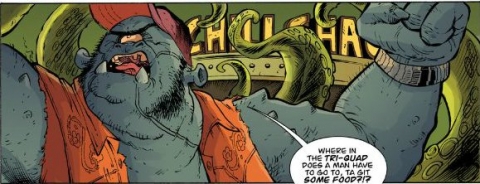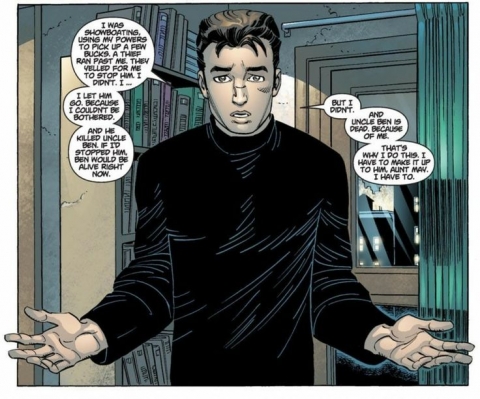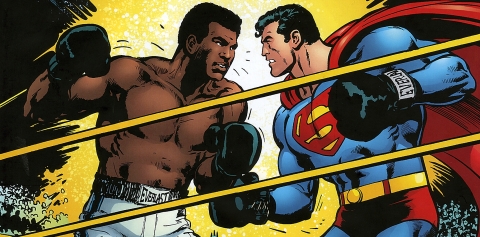52 weeks. 52 different writers. 2 trade paperbacks or hardcovers a week. Each week I’ll take a look at a different writer and read two different collected editions from within that person’s repertoire to help in the examination of their work.
Rick Remender started out as an animator before breaking into comics, working on films like Anastasia, The Iron Giants, and The Adventures of Rocky and Bullwinkle, amongst other works. From the years 2000-2003 he taught a class on comics at the Academy of Art University, whilst also writing, illustrating, and inking multiple series. In the mid-2000’s, Remender launched a plethora of creator owned work before finding his way to Marvel in 2008. Remender quickly ascended towards being a top talent for the company, producing enjoyable runs on books like Punisher, Secret Avengers, and Venom. Remender’s most well-known work for Marvel is undoubtedly his 35 issue run on Uncanny X-Force, following a team of mutants with dark pasts that band together as a black-ops team.
Uncanny X-Force By Rick Remender Volume 1
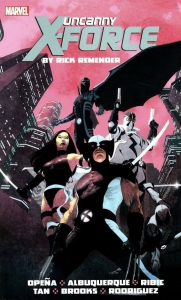 A team of merciless mutants is put together by Wolverine to take on covert missions of dire importance that would destroy anyone with a pure soul. Wolverine brings together the Uncanny X-Force, consisting of Fantomex, Psylocke, Archangel, and Deadpool, all of whom are willing to do whatever it takes to complete the missions they are given. Their first mission takes them to outer space, as they hunt down the reincarnated form of the frequent X-Men foe, Apocalypse. This time around things are different are this form of Apocalypse is nothing more than an innocent child, decades away from becoming the benevolent destroyer he’s supposed to be. Armed with his four horsemen to protect him, Kid Apocalypse watches on as the X-Force struggles with the difficult task of whether or not to kill a child. Their misadventures bring them back down to Earth quickly and awaken a dark beast within Archangel as he begins to struggle with keeping his darker inhibitions at bay. Struggling to find balance between being Warren Worthington and Archangel, the longtime member of the X-Men reconciles his struggles in the loving arms of Psylocke, although, try as she may, it all may be too late to save his soul. With his destiny as the future heir of Apocalypse knocking, the X-Force then must decide if killing one of their own is yet another step too far for this team.
A team of merciless mutants is put together by Wolverine to take on covert missions of dire importance that would destroy anyone with a pure soul. Wolverine brings together the Uncanny X-Force, consisting of Fantomex, Psylocke, Archangel, and Deadpool, all of whom are willing to do whatever it takes to complete the missions they are given. Their first mission takes them to outer space, as they hunt down the reincarnated form of the frequent X-Men foe, Apocalypse. This time around things are different are this form of Apocalypse is nothing more than an innocent child, decades away from becoming the benevolent destroyer he’s supposed to be. Armed with his four horsemen to protect him, Kid Apocalypse watches on as the X-Force struggles with the difficult task of whether or not to kill a child. Their misadventures bring them back down to Earth quickly and awaken a dark beast within Archangel as he begins to struggle with keeping his darker inhibitions at bay. Struggling to find balance between being Warren Worthington and Archangel, the longtime member of the X-Men reconciles his struggles in the loving arms of Psylocke, although, try as she may, it all may be too late to save his soul. With his destiny as the future heir of Apocalypse knocking, the X-Force then must decide if killing one of their own is yet another step too far for this team.
Rick Remender takes several members of the mutant community to dark places with his Uncanny X-Force. Taking a core cast of incredibly flawed characters to begin with, Remender pushes these members of X-Force in ways that just eat at their soul, forcing each and every member of the team to make at least one incredibly harrowing or difficult call. The first mission the team is placed on, dealing with killing the reborn child form of Apocalypse, nearly destroys every member of the team before they even get the chance to see how they truly function as a team. I personally believe that Rick Remender’s take on Uncanny X-Force works because of how well he explores each individual member of this “team”, even though they hardly constitute being such. With Wolverine, Remender casts a clear leader, putting a man who isn’t shy to spill some blood, at the front of a team that needs to do terrible things to ensure that harrowing events can be averted before they even occur. Remender touches on the roots of samurai culture planted on Logan over his rather long life which creates an interesting contrast for some of the calls the character needs to make. Overall, Remender shows he has a firm grasp on the emotional core of the character, displaying a deep understanding of what makes him tick over and over again.
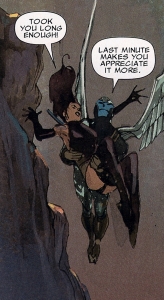 In Deadpool the reader finds an incredibly interesting character that feels like so much more than his usual, comedic self. Typically, Deadpool is seen as a character who only cracks jokes and breaks the fourth wall, of which he still does during this volume of Uncanny X-Force, but it takes on an almost macabre tone at times. The entire tone around the story is rather dreary, with Deadpool often breaking up the grim nature of things with a joke or two, but we see that the lengths the team needs to go to to complete missions begins to wear on him after a time, exposing that he is a character who actually has some level of personal sensitivity and morals. It’s one of the more fascinating takes on Deadpool, exposing readers to a side not often explored.
In Deadpool the reader finds an incredibly interesting character that feels like so much more than his usual, comedic self. Typically, Deadpool is seen as a character who only cracks jokes and breaks the fourth wall, of which he still does during this volume of Uncanny X-Force, but it takes on an almost macabre tone at times. The entire tone around the story is rather dreary, with Deadpool often breaking up the grim nature of things with a joke or two, but we see that the lengths the team needs to go to to complete missions begins to wear on him after a time, exposing that he is a character who actually has some level of personal sensitivity and morals. It’s one of the more fascinating takes on Deadpool, exposing readers to a side not often explored.
If Deadpool is meant to showcase how good Remender is at showing the different sides of a character, then Fantomex, Psylocke, and Archangel are all designed to show how well Remender can evolve characters. At the start of this volume, it’s easy to find Fantomex as a character who isn’t that compelling. He ultimately begins making calls that are equally necessary and terrible for the team, but are also needed for progressing the character along as well. By this volume’s end, it’s hard to argue against Fantomex being your favourite member of the team as he becomes such a fascinating character with so many layers to him thanks to the hidden agendas he has in place. He’s a character who appears to be constantly self-serving but you can’t help but be endeared to because of how engrossed within himself he is. It’s not to the point where he’s obnoxious, it’s to the point where is he almost a character of tragedy, caring for himself so much that it doesn’t cripple him but actually enables him to be a better man. When you speak of tragedy in this story though, it’s hard to not transition from the nature of Fantomex to the relationship between Psylocke and Archangel. The two lovers are strained because of the duality of Angel/Archangel, as both sides of his personality are at war with each other constantly, with Psylocke caught in the middle trying to keep Archangel in check. This dark creature grows inside of Angel, threatening to destroy everything the team sets out to accomplish, with Psylocke constantly trying to keep the beast at bay. How Fantomex influences the relationship between these two characters, as well as how it forces Psylocke’s character to develop beyond her zone of comfort, is a long narrative thread across this entire volume but one that ultimately pays off in a satisfying manner.
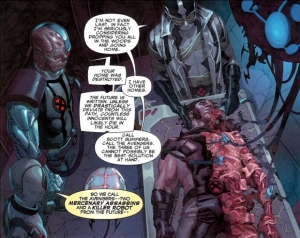 If it wasn’t evident enough by my quick analysis of the members of the team, this story has a lot of moving pieces. Each character has some form of personal stake in the team at one point or another as things progress, whether it be Wolverine dealing with his feelings for a lost lover, the entire team dealing with the consequences of their action, Psylocke trying to protect Angel, Fantomex trying to push his own agenda, or many other things on top of that, there is always larger pieces of a puzzle at play. Rick Remender most certainly plays a long game, not only with the personal struggles of his characters but with the overall plot as well, with key elements of the first arc paying off towards the end of this volume. He even manages to seed in subtle hints of what’s to come at times, while other moments he’s incredibly blatant about what he intends to do. There’s a reason that this volume features over twenty issue of story and it’s not for the sake of convenience for collectors. It’s because so much is constantly happening that it’s important you pay attention.
If it wasn’t evident enough by my quick analysis of the members of the team, this story has a lot of moving pieces. Each character has some form of personal stake in the team at one point or another as things progress, whether it be Wolverine dealing with his feelings for a lost lover, the entire team dealing with the consequences of their action, Psylocke trying to protect Angel, Fantomex trying to push his own agenda, or many other things on top of that, there is always larger pieces of a puzzle at play. Rick Remender most certainly plays a long game, not only with the personal struggles of his characters but with the overall plot as well, with key elements of the first arc paying off towards the end of this volume. He even manages to seed in subtle hints of what’s to come at times, while other moments he’s incredibly blatant about what he intends to do. There’s a reason that this volume features over twenty issue of story and it’s not for the sake of convenience for collectors. It’s because so much is constantly happening that it’s important you pay attention.
One of the only downfalls a reader might find with this volume of Uncanny X-Force is how much it does rely on prior knowledge of these characters and their pasts. If you don’t know about how or why Uncanny X-Force was established in the first place, branching out of other previous X-Men titles, you could feel a little lost at times. Similarly, there’s already pre-established connections between character like Angel and Psylocke, of which the reader has to pick up on. It really is a book that relies on prior reader knowledge, which is completely fair of Remender to do but something readers should still be aware that they might need to know about characters like Apocalypse and Archangel or have some knowledge on what exactly makes Fantomex tick. There are times when the story is really strong because of how Remender crafts unique takes on characters or creates new characters entirely, but then there are moments where, if the reader is reading this as their first X-Men story, they may feel lost. With that all in mind, Rick Remender tackles certain places and timelines from X-Men history, like “Age Of Apocalypse”, in a manner that is highly accessible to the reader. In a few short pages Remender manages to show you everything you’d need to know about the state of that timeline, what occurred, and where things have gone as a result. It’s powerful stuff that can be hit or miss but for the most part Remender knocks the ball out of the park with his Uncanny X-Force.
Collects: Uncanny X-Force #1-19, #5.1, and material Wolverine: Road to Hell #1.
Best Character: Fantomex.
Best Scene/Moment: Fantomex steps up – Issue 4.
Best Line Of Dialogue: “You ever get creeped out by the idea of The Watcher? Real-ly encroaches on lil’Wade’s private time.” – Deadpool.
Best Issue: Issue 3 – The Apocalypse Solution: Chapter 3. This early issue gets a nod for its fantastic work with creating characters. In this issue we are introduced to Apocalypse’s four horsemen and their stories on how they came to be. Each character gets a one page introduction that tells you everything you need to know about them. From there the story launches deeper into Uncanny X-Force’s struggles against these four horsemen as they try to decide if killing Kid Apocalypse is their best course of action.
Why You Should Read It: Simply put, Rick Remender’s Uncanny X-Force underscores how a lot of team books should be. It highlights each character in an interesting way that examines their significance to the team whilst also building their own separate storyline. Remender explores why each member of this team is crucial but also why each member needs the team to back them up. This comic has some of the best depictions you’ll ever find for characters like Wolverine, Deadpool, and Fantomex, while it also gets you interested in other important minor characters like Apocalypses’ four horsemen or even Deathlok. It’s grim, dreary, and all around a rather dark story but it’s still incredibly rewarding.
Fear Agent Volume 1: Re-Ignition
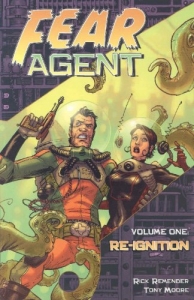 In 2006, Rick Remender launched Fear Agent, a pulp Sci-Fi comic that looked to give the genre the boot in the butt that it desperately needed. The series initially launched with Image comics before moving over to Dark Horse starting with the 12th issue. Remender worked with a rotating series of artists on the series, working with the likes of Tony Moore, Jerome Opena, Francesco Francavilla, and Kevin Dwyer. After working on the title for nearly three years, Remender placed the title on hiatus in 2009 after signing an exclusive contract with Marvel Comics. Remender brought back the series for one final arc in 2010, wrapping it up with the final five issues.
In 2006, Rick Remender launched Fear Agent, a pulp Sci-Fi comic that looked to give the genre the boot in the butt that it desperately needed. The series initially launched with Image comics before moving over to Dark Horse starting with the 12th issue. Remender worked with a rotating series of artists on the series, working with the likes of Tony Moore, Jerome Opena, Francesco Francavilla, and Kevin Dwyer. After working on the title for nearly three years, Remender placed the title on hiatus in 2009 after signing an exclusive contract with Marvel Comics. Remender brought back the series for one final arc in 2010, wrapping it up with the final five issues.
Heath Huston is the last remaining Fear Agent, a small group of alien exterminators from Texas. Travelling all across the universe, Heath spends more time staring at the bottom of a bottle than he does actually exterminating aliens. It’s part of his personally philosophy that he’s better at his job drunk than he is sober. On his way to a fueling and trade pavilion following a mission, Heath is contacted about strange incidences occurring at said pavilion. When he arrives he is stunned to find a deadly type of alien called “Feeders”, whose soul purpose is to consume any and all types of flesh, have completely overrun the joint. Heath discovers that an alien race known as the Dressites, responsible for nearly destroying Earth years before, are planning on assaulting the Earth yet again by dropping Feeders all over the planet. Teaming with the mysterious warp scientist Mara, Heath goes at the Dressites with a wicked hangover and his trigger finger at the ready. Things get complicated when in an attempt to travel back to Earth to warn of the impending Dressite invasion, Heath’s ship crash lands in a totally foreign time and space.
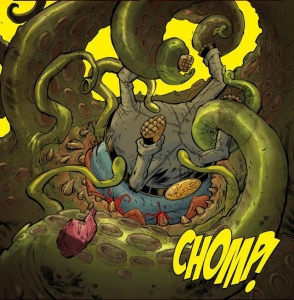 Rick Remender begins to create an incredible, character focused story around Heath Huston in this first volume of Fear Agent. Heath Huston is the runaway lead character in this story, without any else to contest him for the role. While Remender largely uses the first issue to introduce the pulp Sci-Fi nature of the series, in the second issue he full on launches into letting the reader know all the key components of Heath’s character. He’s an alcoholic from Texas who has some nagging ghosts hanging over his head and doesn’t really value much at all in life. Even the A.I. of his ship is something that, although he shows signs of compassion towards her and she the closest thing he has ranging in the realm of a “friend”, he can easily disassociate himself from in the event that he needs to severe any sort of emotional connection. In the simplest of terms, Heath Huston is just a man who wants to get drunk and exterminate some aliens, with anything else that comes along simply being a bonus. There are a few other characters in the story, but none that impact it or share the level of significance towards it that Heath Huston has.
Rick Remender begins to create an incredible, character focused story around Heath Huston in this first volume of Fear Agent. Heath Huston is the runaway lead character in this story, without any else to contest him for the role. While Remender largely uses the first issue to introduce the pulp Sci-Fi nature of the series, in the second issue he full on launches into letting the reader know all the key components of Heath’s character. He’s an alcoholic from Texas who has some nagging ghosts hanging over his head and doesn’t really value much at all in life. Even the A.I. of his ship is something that, although he shows signs of compassion towards her and she the closest thing he has ranging in the realm of a “friend”, he can easily disassociate himself from in the event that he needs to severe any sort of emotional connection. In the simplest of terms, Heath Huston is just a man who wants to get drunk and exterminate some aliens, with anything else that comes along simply being a bonus. There are a few other characters in the story, but none that impact it or share the level of significance towards it that Heath Huston has.
The entire point behind this series, as per Rick Remender, is that it is supposed to be reminiscent of the classic EC stories that captured three key elements, Science Fiction, Horror, and War. Remender sought to use Fear Agent as proof that the Sci-Fi genre wasn’t dead in comics and he most certainly proved himself right with this comic. Each issue appears to encompass some elements known to frequent the science fiction genre, whether it be a variety of alien races and settings, scientific concepts like time travel, or advanced technology that appears to be centuries away from our current time. The concepts that Remender plays with through the character of Heath Huston are definitely fun ones for the reader to explore, as there is always some form of bizarre conflict plaguing him. Remender finds the right balance between believable and outrageous, never veering too far into one realm or the other in favour of alienating a specific type of reader. Instead, the two sides of the Sci-Fi genre strike up a compelling partnership that will keep you guessing and interested as you go along. One of the key aspects to this is the number of different settings Remender manages to pack into this collection, with each issue essentially being set in a different place. With around twenty pages to build characters and worlds, Remender does more than an admirable job of creating locales that will stick with you, either because of how it looks or because of the unique characters within it.
The one thing that truly works against this first collected edition of Fear Agent is its brevity. Just when you really start to get into the overall plot and immerse yourself in the settings is when the stories seem to typically end. It ultimately becomes a great and terrible part of the story as you can take everything you need from the story in just a single issue but you often are still left with more lingering questions than answers. With only four issues to complete this first arc, there isn’t nearly enough time to fully explore everything that you might feel needs attention. It’s a difficult balancing act, providing enough information to the reader to make them feel rewarded while also keeping your cards tight enough to your chest that the reader will want to come back for more, which is a balance Fear Agent does manage to finally achieve by the end of it’s fourth issue. In short, there are plenty of great stories that could serve as one-and-done tales but they still weave in together to create a narrative. The short four issue arc just feels like it robs you a little bit of potential payoff for certain story beats but still leaves you wanting to come back for more.
Collects: Fear Agent #1-4.
Best Character: Heath Huston.
Best Line Of Dialogue: “Every hour is happy hour.” – Heath Huston.
Best Scene/Moment: Heath and Mara’s fight for survival – Issue 3.
Best Issue: Issue 4. This issue concludes the first volume in dramatic fashion, leaving readers with one heckava cliffhanger. It’s an issue that fleshes out the back story on some of the current threats in Heath’s life, and does so by showing an example of exposition done well. It’s a story with a solid build up, decent twists, strong character moments, and there’s that cliffhanger I mentioned at the start of this paragraph. By the end of this issue, you’ll be easily convinced of whether or not you want to continue on with the journeys of Heath Huston and his Fear Agent ways.
Why You Should Read It: This series, not just the first volume, is worth any Sci-Fi fans time. The way the story handles itself is compelling enough to convince even the most judgemental of readers to keep trudging along. The somewhat one-and-done nature of the issues is like a modern spin on classic comics, in the sense that you’d get everything you’d need from a story within 20+ pages but it would also feed into a larger narrative, sharply contrasting with today’s comic market that seems consistently geared towards 6+ issue arcs designed to conveniently fit into a collected edition somewhere down the road. You’ve got a loveable badass, high Sci-Fi concepts, plenty of fascinating story beats, settings, and alien races plus so many other entertaining facets to this comic.


